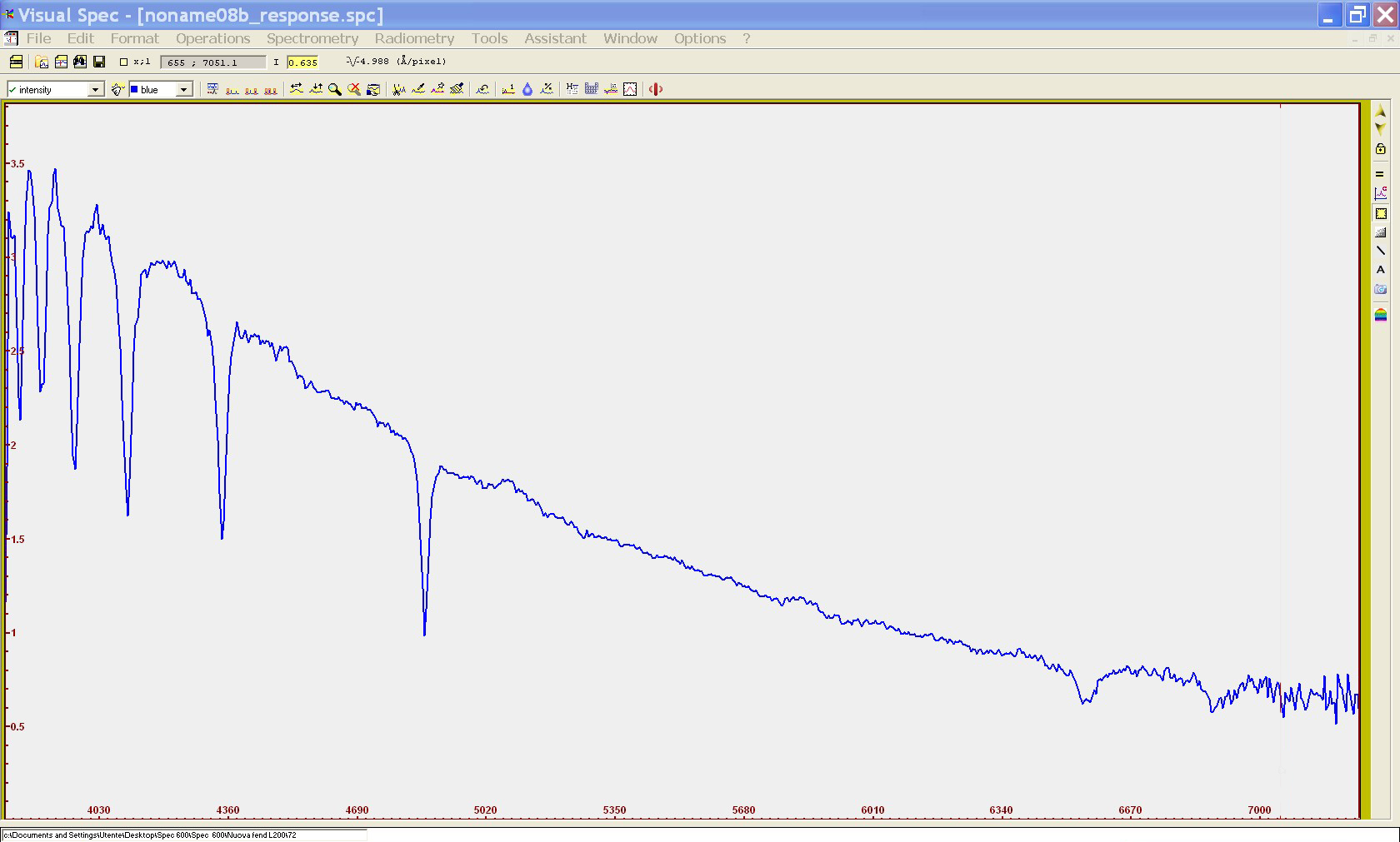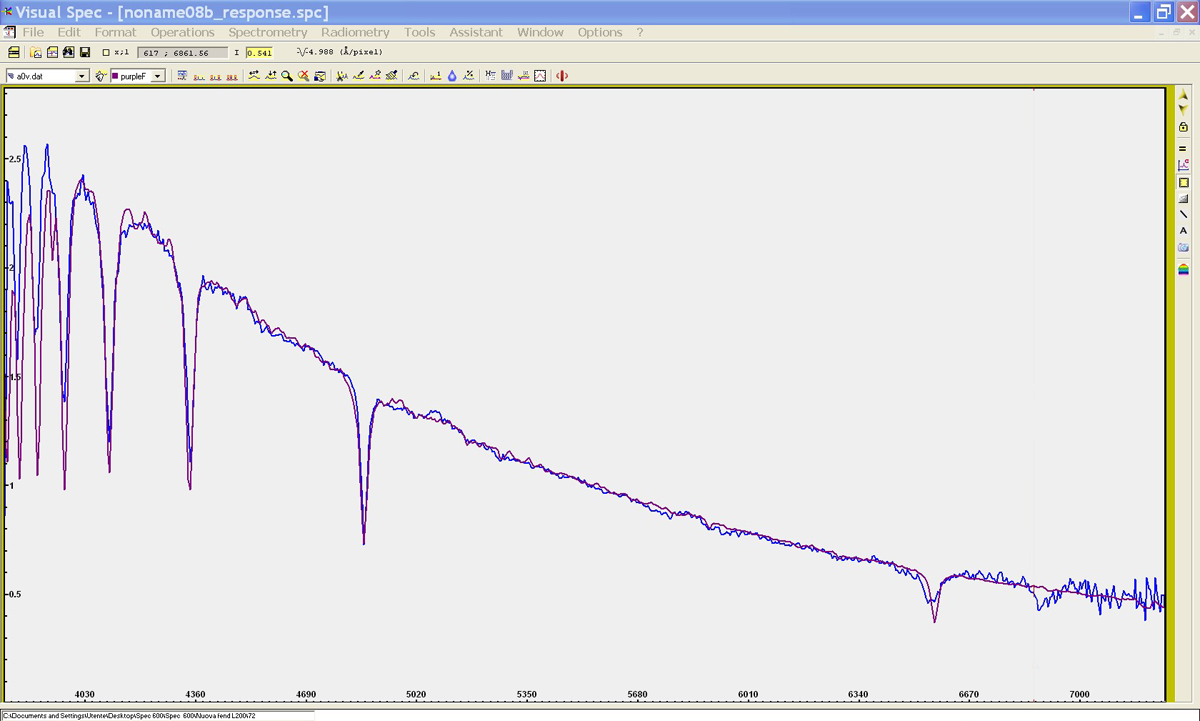
SPEC 600
Un progetto di spettroscopio a fenditura a media risoluzione a basso costo
A low cost medium resolution slit spectroscope
Molti astrofili potenzialmente interessati di spettroscopia stellare operano esclusivamente a bassa risoluzione con reticoli da 100-200 l/mm in fascio convergente per la spesa notevole richiesta da uno spettroscopio a fenditura, spesa che potrebbe rivelarsi poco utile nel caso di successivo affievolimento dell'interesse ed abbandono della specifica materia.D'altro canto, l'uso di uno spettroscopio a fenditura è il passo successivo per coloro che hanno dimostrato interesse e capacità per la spettroscopia a bassa risoluzione, in quanto permette di liberarsi dal predominio del seeing che condiziona, come sappiamo, le riprese CCD di oggetti puntiformi.Nella spettroscopia a fenditura è infatti l'apertura e la qualità della fenditura e non il seeing, a determinare la risoluzione del nostro spettroscopio sulle immagini stellari e, cosa ancora più importante, sugli oggetti estesi (nebulose, galassie, etc) sui quali gli spettroscopi in fascio convergente non possono operare, se non a livelli qualitativi esclusivamente dimostrativi delle macroscopiche emissioni od assorbimenti dell'oggetto.
Many amateurs potentially interested in spectroscopy operate exclusively with low-resolution gratings of 100-200 g/ mm in convergent beam for the considerable expense required by a slit spectroscope , spending that could prove useless in the case of subsequent weakening of the interest and abandonment of specific matter.On the other hand, the use of a slit spectroscope is the next step for those who have shown interest and capacity for low-resolution spectroscopy, as it allows to break free from the dominance of seeing that conditions, as we know , the CCD imaging of stellar objects .In the slit spectroscopy is ,in fact, the opening and the quality of the slit and not the seeing, to determine the resolution of our spectroscope on stellar images and, more importantly, on extended objects (nebulae, galaxies, etc) on which the spectroscope in convergent beam can not work, if not in quality levels only demonstration of macroscopic emission or absorption of the object.
Il problema da affrontare è tuttavia sempre lo stesso, uno spettroscopio commerciale a fenditura completo e degno di tale nome ha mediamente un costo che si aggira tra i 1500 e 3500 €.Ora, sono ben pochi i novizi di tale materia di medie possibilità economiche disposti ad investire una cifra così considerevole in un'esperienza che potrebbe non avere seguito per vari motivi (difficoltà tecniche, mancanza di tempo, etc) ; ciò fa si che molti restino al livello del pur eccellente Star analyser 100 o 200, privandosi della possibilità di ottenere spettri di buona qualità e risoluzione e, quel che più conta, che prescindano dal seeing e siano sufficientemente comparabili tra loro o con quelli altrui quanto a flusso e dispersione.Mi sono quindi posto un budget massimo di 500 €,da non superare, in una realizzazione parzialmente casalinga, dico parzialmente in quanto si avvale di componenti rinvenibili sul mercato, anche di surplus.Il progetto concerne uno spettrografo a media risoluzione da 600 L/mm con fenditura riflettente e modulo di guida, simile concettualmente all'ottimo Alpy di Shelyak, che tuttavia costa 1500 € senza modulo di calibrazione.
The problem to be solved is, however, always the same, a commercial slit spectroscope complete and worthy of the name has an average cost that is between 1500 and 3500 € .Now, there are very few novices in this field of medium economic capacity willing to invest a sum so considerable in an experience that could not be followed for various reasons (technical difficulties, lack of time, etc) c; This means that many remain at the level of the excellent Star analyzer 100 or 200, depriving themselves of the opportunity to obtain spectra of good quality and resolution and, most importantly, not depending by seeing and that are sufficiently comparable with each other or with those of others both as dispersion and flux.I set a maximum budget of € 500, not to exceed, in a partial housewife realization, I say partially because it uses components found on the market, even that of surplus.The project tackles a medium resolution spectrograph 600 g / mm with reflective slit and guide module, similar in concept to the excellent Alpy by Shelyak, however that costs 1500 € (without calibration module).
I componenti usati sono stati i seguenti:
Grism (reticolo di diffrazione a trasmissione+ prisma per riallineare il fascio ottico) da 12 mm
The components used were as follows:
Grism (transmission grating + prism in order to realign the optical path) 12 mm
Modulo di guida con sistema a fenditure multiple dell'L 200 di Ken Harrison, commercializzato da JTW Astronomy
Guiding module with a multiple slit plate similar to the one of Ken Harrison's L200 marketed by JTW Astronomy.

La piastra multifenditura, con 9 fenditure di diversa apertura
The multiple slit plate, with 9 slits of different apertures
Box in alluminio con portaoculari superiore registrabile e due ingressi filettati da 42 x 1 mm: il modulo di guida ha dovuto essere fresato leggermente ai bordi per poter essere acconto all'interno della scatola di guida .
Aluminum box with an adjustable eyepiece holder and two threaded holes 42 X1; the

Il costo complessivo è risultato pari a circa 400 € :
100 € lo spettroscopio didattico
150 € il modulo di guida di JWT Astronomy con la piastra a fenditure riflettenti multiple
100 € il box di alluminio
30 € un doppietto acromatico di 50 mm di focale per il collimatore ed un piccolo obiettivo simmetrico da 32 mm come ottica della camera, entrambi da Surplushed
20 € un piccolo specchietto ed un doppietto acromatico da 50 m circa di rinvio dell'immagine della fenditura, entrambi ancora di Surplushed.
Per soli 400 € mi sono trovato quindi in possesso di uno strumento semplice ed efficiente per la spettroscopia stellare.
Il layout dello strumento è il seguente:
The overall cost was about of 400 €, as follows:
100 € the educational spectroscope ;
150 € the guiding module with the slit plate;
100 € the aluminum box;
30 € an acro doublet 50 mm EFL used as collimator,and a 32 mm simmetric lens used as camera optics;
20 € a small plane mirror and a acro doublet as relay lens;

lo spettroscopio è ottimizzato per un fascio ottico di F/D 5-7, ma sembra rendere bene anche con strumenti a f 10-12.La dispersione spettrale è di circa 4.9 A con una camera con pixel da 6.45 micron.
The spectroscope was optimized for an optical beam of F/D 5-7, but it seems to work quite well also with F/D ratios of 10-12
Nell'immagine che segue lo Spec 600 al fuoco di un eccellente Celestron 8 vintage, con una camera CCD Atik 16 HR.
In the following image the instrument at the focus of an excellent vintage orange C8
Alcuni esempi di spettri ottenibili con tale strumento per diverse aperture di fenditura riflettente:
Some examples of spectra obtained by Spec 600

Spettro della parte centrale di M42 ottenuto con la somma di 20 immagini da 20 sec con lo Spec 600 al fuoco di un rifrattore 80/ 560 ED, fenditura da 70 micron; notevole la resa dello strumento con una fenditura così aperta.
M42 central zone spectrum, obtained from a sum of 20x 20 sec frames at the focus of a 80/560 ED refractor, 70 micron slit: noticeable the output with such a large slit aperture.

Spettro di Alphecca (Alpha CrB) classe A05, ottenuto al fuoco di un Matsukov 127/1500, sempre con la fenditura da 72 micron
Alphecca (Alpha CrB), A05 class, at the focus of a 127/1500 matsukov

Notevole la resa dello stesso spettro sovrapposto a quello professionale di una stella della stessa classe preso dalla libreria di Visual Spec.
Remarkable the comparison of previous spectrum superimposed to the professional one of a star of the same spectral class taken from the Visual Spec library.

Spettro di Beta Lyrae (Shelyak) preso con un Celestron 14 ed una camera Atik 16 HR (sensore Sony ICX 285 AL),con evidenti le righe di emissione dell' He1
Spectrum of Beta Lyrae (Shelyak), taken by a Celestron 14 and an Atik 16 HR camera (Sony ICX 285 AL), with evident He1 lines